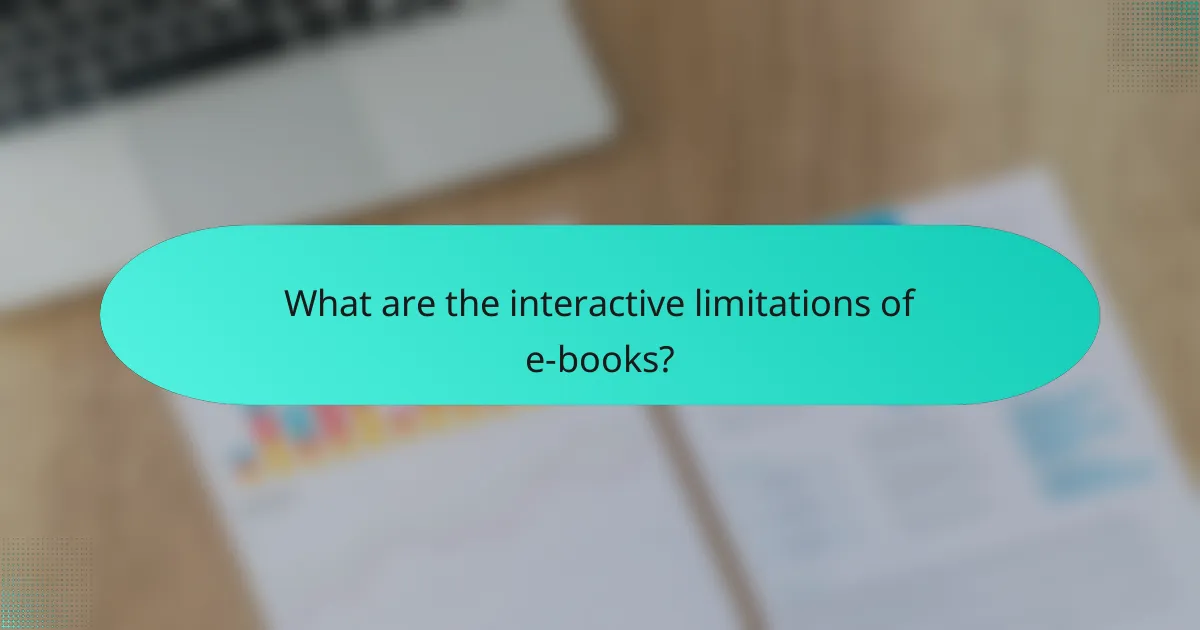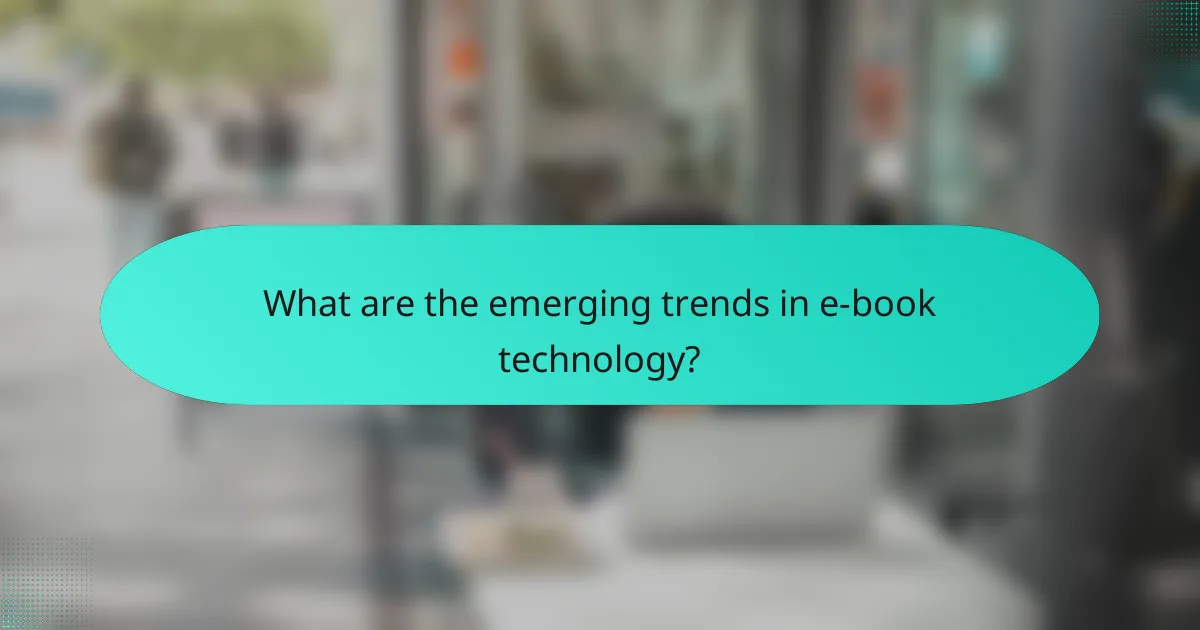E-books have transformed the reading experience, but they come with challenges such as device dependency, which can restrict access and interaction across different platforms. While they offer some interactive elements, these features are often limited compared to more dynamic digital formats. Additionally, piracy remains a significant concern, threatening the financial viability of authors and publishers by facilitating unauthorized distribution of their work.

How can device dependency affect e-book usage?
Device dependency can significantly impact how users access and interact with e-books. If an e-book is designed for a specific device or platform, users may face limitations in accessing their content on other devices, which can hinder their reading experience.
Limited access on non-compatible devices
Many e-books are formatted for specific devices or applications, such as Kindle or Apple Books. This means that users with non-compatible devices may be unable to open or read certain e-books, restricting their choices. For instance, a user with a basic e-reader may not be able to access e-books that require advanced features available only on tablets or smartphones.
To avoid this issue, readers should check the compatibility of e-books with their devices before purchase. Using universal formats like EPUB can help, but not all e-books are available in these formats.
Impact on reading experience
The reading experience can vary greatly depending on the device used. E-readers typically offer a more comfortable reading experience with features like e-ink displays, which reduce eye strain compared to backlit screens on tablets. However, tablets may provide richer interactivity and multimedia options that enhance engagement.
Readers should consider their preferences for comfort versus interactivity when choosing devices. For example, a user who enjoys annotations and multimedia may prefer a tablet, while someone focused on long reading sessions might opt for an e-reader.
Device-specific features
Different devices come with unique features that can enhance or limit e-book usage. For example, Kindle devices offer Whispersync, which syncs reading progress across devices, while some tablets allow for interactive content like videos and quizzes. These features can greatly influence how users engage with e-books.
When selecting a device, users should evaluate which features matter most to them. If seamless syncing and ease of use are priorities, a device with strong ecosystem support, like Kindle or Apple, may be preferable. Conversely, if interactivity is key, a tablet with robust app support could be the better choice.

What are the interactive limitations of e-books?
E-books often face interactive limitations due to their reliance on static content and restricted dynamic features. While they can offer some interactivity, such as hyperlinks and multimedia elements, these features are typically less engaging compared to other digital formats like apps or websites.
Static content vs. dynamic features
Static content in e-books refers to text and images that do not change or respond to user input. This includes traditional narratives and illustrations that remain fixed. In contrast, dynamic features allow for user interaction, such as quizzes, animations, or embedded videos, which can enhance the reading experience but are often limited in e-books.
The trade-off between static and dynamic content is significant. While static content ensures compatibility across various devices, dynamic features can provide a more immersive experience. However, not all e-book formats support these interactive elements, which can restrict their availability and functionality.
Examples of interactivity in popular e-books
Some popular e-books incorporate limited interactivity, such as hyperlinks that lead to external resources or embedded audio clips. For instance, educational e-books may include quizzes at the end of chapters to reinforce learning, while children’s e-books might feature read-aloud options or simple animations.
However, these interactive elements are often basic compared to what is available in dedicated apps. Readers looking for a more engaging experience may find that many e-books do not fully utilize the potential for interactivity, leading to a preference for other digital formats when seeking dynamic content.

What are the piracy concerns associated with e-books?
Piracy concerns related to e-books primarily involve unauthorized distribution and reproduction of digital content. This illegal activity undermines the revenue streams for authors and publishers, making it a significant issue in the digital publishing industry.
Common piracy methods
Common methods of e-book piracy include torrenting, where users share files through peer-to-peer networks, and the use of websites that host pirated content. Additionally, some individuals may convert e-books into different formats to bypass digital rights management (DRM) protections, making them easier to share illegally.
Another prevalent method is the use of social media platforms and forums where users can share links to pirated e-books. These platforms often facilitate the rapid spread of unauthorized copies, making it challenging for rights holders to combat the issue effectively.
Impact on authors and publishers
The impact of e-book piracy on authors and publishers can be severe, leading to significant financial losses. When e-books are pirated, authors may receive lower royalties, which can affect their ability to produce new works. Publishers may also face reduced sales, leading to budget cuts and fewer resources for marketing and distribution.
Moreover, the prevalence of piracy can devalue the perceived worth of e-books among consumers. When readers can easily access pirated versions, they may be less willing to pay for legitimate copies, further exacerbating the challenges faced by the publishing industry.

How can users protect their e-books from piracy?
Users can protect their e-books from piracy by utilizing Digital Rights Management (DRM) solutions and understanding the legal implications of sharing e-books. These methods help ensure that e-books remain secure and that authors and publishers receive fair compensation for their work.
Digital Rights Management (DRM) solutions
Digital Rights Management (DRM) solutions are technologies that control how e-books are used and distributed. They can restrict copying, sharing, and printing, which helps to prevent unauthorized access. Common DRM systems include Adobe Digital Editions and Amazon’s Kindle DRM, which are widely used by publishers.
When choosing e-books, consider those that come with DRM protection if you want to support authors and publishers. However, be aware that DRM can limit your ability to access your e-books across different devices or platforms, which may affect your reading experience.
Legal implications of e-book sharing
Sharing e-books without permission can lead to legal consequences, including fines or lawsuits. Copyright laws protect the rights of authors and publishers, making unauthorized distribution illegal in many countries. For instance, in the United States, the Digital Millennium Copyright Act (DMCA) enforces strict penalties against copyright infringement.
To avoid legal issues, always purchase e-books from reputable sources and respect the terms of use. If you want to share an e-book, check if the publisher allows lending or sharing under specific conditions, as some platforms offer limited sharing options legally.

What are the best practices for e-book consumption?
To optimize e-book consumption, select the right device and utilize available library services. These practices enhance accessibility, improve reading experiences, and can save costs.
Choosing the right device
Selecting the appropriate device for e-book reading is crucial for comfort and usability. Consider factors such as screen size, battery life, and weight. E-readers like Kindle or Kobo are designed for reading and often have features like glare-free screens and long battery life, making them ideal for extended use.
Tablets and smartphones offer versatility but may lead to distractions due to notifications. If you prefer a multi-functional device, ensure it has a good reading app and sufficient battery life for long sessions. Aim for devices with at least 8-inch screens for a comfortable reading experience.
Utilizing library services for e-books
Many local libraries offer e-book lending services, allowing you to borrow titles for free. Check if your library partners with platforms like OverDrive or Libby, which provide access to a vast selection of e-books. You typically need a library card to register and borrow titles.
Be aware of borrowing limits and return periods, which can vary by library. Most e-books are available for a few weeks, and you can renew them if no one else has requested them. This service can significantly reduce your e-book costs while expanding your reading options.

What are the emerging trends in e-book technology?
Emerging trends in e-book technology focus on enhancing user experience through interactivity, accessibility, and innovative business models. Key developments include the integration of augmented reality, the rise of subscription services, and advancements in e-reader devices.
Integration of augmented reality
Augmented reality (AR) is increasingly being integrated into e-books to create immersive reading experiences. This technology allows readers to interact with content in new ways, such as visualizing complex concepts or exploring 3D models related to the text.
For example, educational e-books may use AR to overlay interactive diagrams or animations that enhance comprehension. This trend not only makes reading more engaging but also caters to various learning styles.
Growth of subscription models
Subscription models for e-books are gaining popularity, providing readers with access to vast libraries for a monthly fee. Services like Kindle Unlimited and Scribd allow users to explore a wide range of titles without the need for individual purchases.
This model benefits both consumers and publishers, as it encourages reading while providing a steady revenue stream for authors. However, readers should be mindful of the limitations on title availability and the need for ongoing subscriptions.
Advancements in e-reader technology
Recent advancements in e-reader technology have significantly improved the reading experience. Modern devices now feature high-resolution displays, adjustable lighting, and longer battery life, making them more user-friendly.
Some e-readers also support various file formats and offer built-in dictionaries, note-taking capabilities, and cloud storage options. When choosing an e-reader, consider factors like screen size, weight, and compatibility with your preferred e-book formats to find the best fit for your reading habits.
